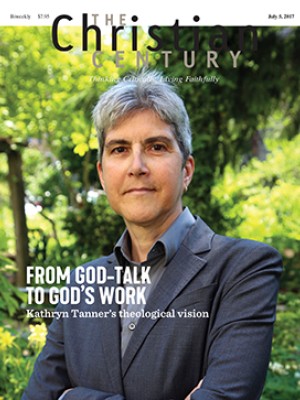Haunted by its history, Berlin debates restoring the kaiser’s gilded cross
Berlin is a city haunted by history. It is constantly debating what to do with the reminders of its Nazi past, its communist legacy, or its Prussian kings and imperial kaisers. Now there’s a dispute about one of its oldest symbols of all: a cross.
The debate arose because the reconstruction of the City Palace (Stadtschloss), a residence of kings and kaisers, which was heavily damaged in World War II and demolished by East Germany’s communist leaders in 1950, is moving into its final phase.
Read our latest issue or browse back issues.
The foundation overseeing the project announced recently that an unnamed donor has pledged funds to top off its cupola with a gilded Christian cross, like the one that stood there until the old palace was torn down.
This has sparked a public debate in Berlin, a traditionally Protestant city where two-thirds of the residents don’t belong to any church and there may be more Muslims than Catholics.
Opponents of the cross are mostly on the political left.
“It’s supposed to be a public building where everyone feels welcome,” said Sigrid Hupach, culture spokeswoman for the Greens in the German parliament. “But how can there be an open dialogue of cultures if a cross up on the cupola shows what direction it should go in?”
Berlin’s churches, as well as some conservative politicians and the business elite, have defended the cross, some vociferously.
“These hedonistic leftists and Greens, who have no interest in Christian culture, have seized the moment to denounce the cross,” fundraiser Wilhelm von Boddien complained.
Germany’s Central Council of Muslims said it has no problem with a Christian symbol. “The cross belongs on the cupola because the building has a historical context and that’s related to Christianity,” said council chairman Aiman Mazyek.
If Berlin wanted something different on the cupola, he added, it should consider putting up a symbol combining the Christian cross, Muslim crescent, and Jewish Star of David.
The city’s atheist association has suggested that the rebuilt palace, due to open in 2019, should be topped with a microscope.
Debates like this have erupted almost every time that Berlin has had to decide what to do with the monumental buildings left over from its past, such as the huge headquarters of Hitler’s central bank, which later housed the Communist Party’s Central Committee.
The City Palace has been especially controversial because it is the only building reconstructed from scratch. In addition, the campaign to resurrect the royal residence seemed to be driven by nostalgia for the old kingdom of Prussia, which to many Germans symbolizes militarism.
One of the leading defenders of the cross is Richard Schröder, a theologian and leader among the East German Protestant pastors who guided the democracy movement that finally forced the Berlin Wall open in 1989.
Schröder, who has also been a Social Democratic parliamentarian and head of the theology faculty at Berlin’s Humboldt University, likes to remind Germans that Prussia was also a multicultural and multireligious kingdom that took in the Protestant Huguenot refugees from France and had a large Jewish minority. Yet he is no apologist for the old authoritarian monarchy.
“With the cross atop his palace, the Prussian king was also thinking of the divine right of kings that he invoked against popular sovereignty and democracy,” Schröder said. “That’s the way it was, that’s the way he was, and no iconoclasm can change that. But we cannot act as censors of history in reconstructing the palace. Otherwise, we’ll end up with Orwell’s Ministry of Truth.”
Unsurprisingly, Christian leaders in Berlin want to see the palace’s cross restored.
Catholic archbishop Heiner Koch said the cross was “the sign of the good news of the Christian faith for all people” and should not become a political football.
Protestant bishop Markus Dröge said the cross was a sign of reconciliation and noted that Christians, Muslims, Jews, and atheists gathered in a Berlin church last December for a memorial service for the 12 people killed outside it when a militant drove a heavy truck through the crowded Christmas market.
“Whoever rebuilds and simply leaves out what they don’t like destroys the historical context and betrays a skewed understanding of history,” he said. —Religion News Service
A version of this article, which was edited on June 16, appears in the July 5 print edition under the title “Berlin debates restoring cross atop City Palace.”





